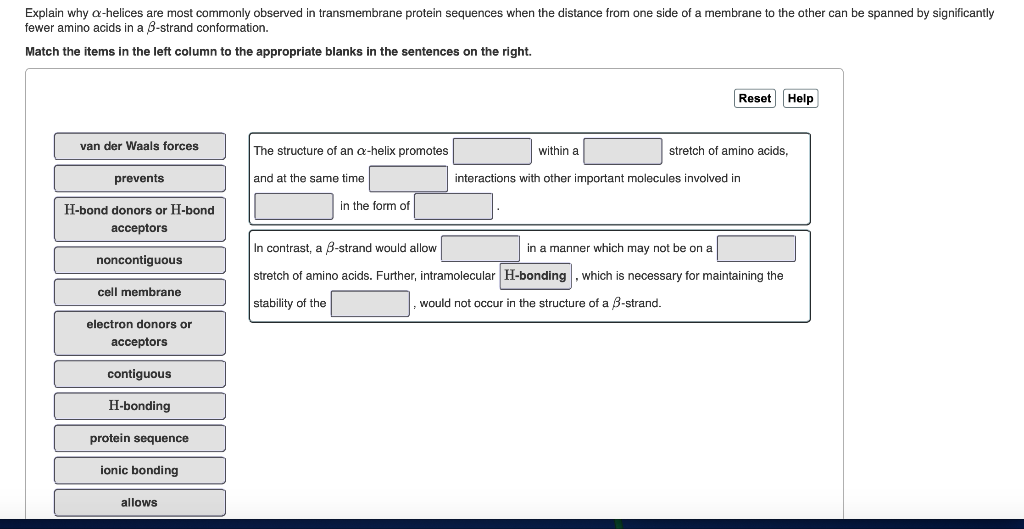Explain why a-helices are most commonly observed in transmembrane protein sequences when the distance from one side of a membrane to the other can be spanned by significantly fewer amino acids in a B-strand conformation. Match the items in the left column to the appropriate blanks in the sentences on the right. Reset Help van der Waals forces The structure of an a-helix promotes within a stretch of amino acids, prevents and at the same time interactions with other important molecules involved in H-bond donors or H-bond in the form of acceptors In contrast, a B-strand would allow in a manner which may not be on a noncontiguous stretch of amino acids. Further, intramolecular H-bonding, which is necessary for maintaining the cell membrane stability of the would not occur in the structure of a B-strand. electron donors or acceptors contiguous H-bonding protein sequence ionic bonding allows
Explain why a-helices are most commonly observed in transmembrane protein sequences when the distance from one side of a membrane to the other can be spanned by significantly fewer amino acids in a B-strand conformation. Match the items in the left column to the appropriate blanks in the sentences on the right. Reset Help van der Waals forces The structure of an a-helix promotes within a stretch of amino acids, prevents and at the same time interactions with other important molecules involved in H-bond donors or H-bond in the form of acceptors In contrast, a B-strand would allow in a manner which may not be on a noncontiguous stretch of amino acids. Further, intramolecular H-bonding, which is necessary for maintaining the cell membrane stability of the would not occur in the structure of a B-strand. electron donors or acceptors contiguous H-bonding protein sequence ionic bonding allows
Biology Today and Tomorrow without Physiology (MindTap Course List)
5th Edition
ISBN:9781305117396
Author:Cecie Starr, Christine Evers, Lisa Starr
Publisher:Cecie Starr, Christine Evers, Lisa Starr
Chapter7: Gene Expression And Control
Section: Chapter Questions
Problem 2CT
Related questions
Question
Fill up correct options.

Transcribed Image Text:Explain why a-helices are most commonly observed in transmembrane protein sequences when the distance from one side of a membrane to the other can be spanned by significantly
fewer amino acids in a B-strand conformation.
Match the items in the left column to the appropriate blanks in the sentences on the right.
Reset Help
van der Waals forces
The structure of an a-helix promotes
within a
stretch of amino acids,
prevents
and at the same time
interactions with other important molecules involved in
H-bond donors or H-bond
in the form of
аcсeptors
In contrast, a B-strand would allow
in a manner which may not be on a
noncontiguous
stretch of amino acids. Further, intramolecular H-bonding, which is necessary for maintaining the
cell membrane
stability of the
would not occur in the structure of a 3-strand.
electron donors or
acceptors
contiguous
H-bonding
protein sequence
ionic bonding
allows
Expert Solution
This question has been solved!
Explore an expertly crafted, step-by-step solution for a thorough understanding of key concepts.
This is a popular solution!
Trending now
This is a popular solution!
Step by step
Solved in 2 steps

Knowledge Booster
Learn more about
Need a deep-dive on the concept behind this application? Look no further. Learn more about this topic, biology and related others by exploring similar questions and additional content below.Recommended textbooks for you

Biology Today and Tomorrow without Physiology (Mi…
Biology
ISBN:
9781305117396
Author:
Cecie Starr, Christine Evers, Lisa Starr
Publisher:
Cengage Learning

Biology Today and Tomorrow without Physiology (Mi…
Biology
ISBN:
9781305117396
Author:
Cecie Starr, Christine Evers, Lisa Starr
Publisher:
Cengage Learning